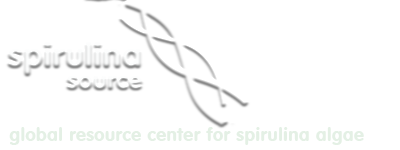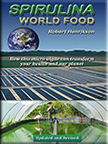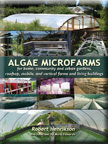REFERENCES AND ABSTRACTS BY HEALTH CATEGORY
Spirulina scientific reference library. Over 100 references covering 45 years of international research.
Click on PDF Download button for free pdf file.
![]() Evaluation of Microalgae Antiviral Activity and Their Bioactive Compounds. by Dora Allegra Carbone et al.Pub. in Antibiotics 2021, 10, 746. https://doi.org/10.3390/antibiotics10060746. 2021. Italy.
Evaluation of Microalgae Antiviral Activity and Their Bioactive Compounds. by Dora Allegra Carbone et al.Pub. in Antibiotics 2021, 10, 746. https://doi.org/10.3390/antibiotics10060746. 2021. Italy.
Photosynthetic organisms such as microalgae are known to be a reservoir of bioactive secondary metabolites; this feature, coupled with the possibility of achieving very high biomass levels without excessive energetic expenses, make microalgae worthy of attention in the search for new molecules with antiviral effects. In this work, the antiviral effects of microalgae against some common human or animal viruses were considered, focusing our attention on some possible effects against SARS-CoV-2. We summed up the data from the literature on microalgae antiviral compounds, from the most common ones, such as lectins, polysaccharides and photosynthetic pigments, to the less known ones, such as unidentified proteins. We have discussed the effects of a microalgae-based genetic engineering approach against some viral diseases. We have illustrated the potential antiviral benefits of a diet enriched in microalgae.
![]() Could microalgae-derived antiviral compounds combat SARS CoV-2 and other viruses? by Liji Thomas, MD. 2021. India.
Could microalgae-derived antiviral compounds combat SARS CoV-2 and other viruses? by Liji Thomas, MD. 2021. India.
Microalgae produce a variety of chemicals, such as carbohydrate-binding proteins, called lectins; polysaccharides with sulfate groups and acidic polysaccharides; pigments; peptides and proteins; flavonoids and polyphenols; and glycolipids. Polysaccharides are produced by the well-known Spirulina and Porphyridium microalgae. Sulfate polysaccharides may occupy the viral attachment sites on the viral envelope. Other promising sulfate-polysaccharides from Spirulina include the calcium-spirulan (Ca-SP), which is active against HIV1 and HSV. Microalgal supplements could be used in the diet to counteract SARS-CoV-2 infection. Spirulina activates the immune system by virtue of its Braun-type lipoproteins that trigger Toll-like receptors. A spirulina-rich diet may help fight HIV infection, which may be linked to the lower incidence of HIV infection.
Conclusion: microalgae display eco-friendly and eco-sustainable characteristics, produce a high variety of antiviral compounds, and can be used as a supplement in diets without collateral effects. Moreover, these organisms are considered very good candidates for the genetic engineering approach.
Calcium Spirulan, an inhibitor of enveloped virus replication, from a blue-green alga Spirulina.
by Hayashi et al. 1996. Pub. in Journal of Natural Products, 59, 83-87. Japan.
Bioactivity-directed fractionation of a hot H2O extract from a blue-green-alga Spirulina platensis led to the isolation of a novel sulfated polysaccharide named Calcium Spirulan (Ca-SP) as an antiviral principle. This polysaccharide was composed of rhamnose, ribose, mannose, fructose, galactose, xylose, glucose, glucuronic acid, galacturonic acid, sulfate and calcium. Ca-SP was found to inhibit the replication of several enveloped viruses, including Herpes simplex virus type 1, human cytomegalovirus, measles virus, mumps virus, influenza A virus and HIV-1. It was revealed that Ca-SP selectively inhibited the penetration of virus into host cells. Retention of molecular conformation by chelation of calcium ion with sulfate groups was suggested to be indispensible to its antiviral effect.
An extract from spirulina is a selective inhibitor of herpes simplex virus Type 1 Penetration into HeLa Cells.
by Hayashi et al. 1993. Pub. in Phytotherapy Research, Vol. 7. 76-80. Japan.
The water soluble extract of spirulina achieved a dose-dependent inhibition of the replication of herpes simplex virus type 1 (HSV-1) in HeLa cells within the concentration range of 0.08-50 mg/mL. This extract proved to have no virucidal activity and did not interfere with adsorption to host cells. However, the extract affected viral penetration in a dose-dependent manner. At 1 mg/ml the extract was found to inhibit virus-specific protein synthesis without suppressing host cell protein synthesis if added to the cells 3 hours before hamsters at doses of 100 and 500 mg/kg per day.
Effects of polysaccharide and phycocyanin from spirulina on peripheral blood and hematopoietic system of bone marrow in mice.
by Zhang Cheng-Wu, et al.. April 1994. Nanjing Univ. China. Pub. in Proc. of Second Asia Pacific Conf. on Algal Biotech. Univ. of Malaysia. China.
C-phycocyanin and polysaccharide were isolated and purified from spirulina. By using the techniques of colony forming unit-erythroid (CFU-E) culture of fetal liver cells in mice in vitro, C-phycocyanin was found to possess high erythropoietin (EPO) activity. The effects of polysaccharide and phycocyanin on the periphyeral blood and bone marrow hematopoietic stem and progentitor cell in normal, irradiated and anemic mice were studied. These studies demonstrate the unique capacity of C-phycocyanin and polysaccharide to influence the differentation and proliferation of committed hematopoietic progenitor cell. Stimulated recovery by C-phycocyanin and polysaccharide was observed in leukocyte and bone marrow nucleated cell counts and the number of CFU-GM colony formation in mice after single whole-body gamma-ray irradiation. The C-phycocyanin and polysaccharide can lower the anemic degree of mice combined with treatment of gamma-ray irradiation and benzohydrazine hydrochloric acid peritonerl injection.
Enhancement of antibody production in mice by dietary spirulina.
by Hayashi, et al. June 1994. Kagawa Nutrition Univ. Japan. Pub. in Journal of Nutr. Science and Vitaminology. Japan.
Mice fed a spirulina diet showed increased numbers of splenic antibody- producing cells in the primary immune response to sheep red blood cells (SRBC). However, immunoglobulin G (IgG) – antibody production in the secondary immune response was hardly affected. The percentage of phagocytic cells in peritoneal macrophages from the mice fed spirulina diet, as well as the proliferatiom of spleen cells, was significantly increased. Addition of a hot-water extract of spirulina (SHW) to an in vitro culture of spleen cells markedly increased proliferation of these cells, whereas culture of thymus cells was scarcely affected. The spirulina extract also significantly enhanced interleukin-1 (IL-1) production from peritoneal macrophages. Addition to the in vitro spleen cell culture of SHW as well as the supernatant of macrophages stimulated with SHW resulted in enhancement of antibody production, that is, an increase of the number of PFC. These results suggest that spirulina enhances the immune response, particularly the primary response, by stimulating macrophage functions, phagocytosis, and IL-1 production.
Immune enhancement potential of spirulina in chickens.
by M. Quereshi, et al. August 1994. Poultry Science Assoc. Dept. of Poultry Science, North Carolina State, NC. Pub. in Journal of Poultry Science Vol 73, S1. p.46. USA.
Effects of spirulina on the immune function of chickens were examined. Macrophage cultures treated with a water soluble extract of spirulina exhibited enhanced phagocytosis and induced tumorcidal factor secretion. In the second study, 0, 10, 100 and 10,000ppm spirulina in corn/soy diets were fed to Leghorn chickens. Larger thyus glands, higher NK activity and CBH response were observed in the 10,000ppm spirulina treated chickens. Percent phagocytic macrophages and secondary antibody response were also greater than non-treated chickens. The data suggests spirulina exposure improves immune performance of chickens without adversely affecting other performance characteristics.
Immunomodulary effects of spirulina supplementation in chickens.
by M. Qureshi, et al. May 1995. North Carolina State. Pub. in Proc. of 44th Western Poultry Disease Conference, pp 117-120. USA.
Chicken macrophages exposed to a water-soluble spirulina extract show enhanced phagocytic activity in vitro suggesting activation of mononuclear phagocytic system function. Furthermore, dietary supplementation of Spirulina (1,000 ppm to 10,000 ppm) improved thymic weights, enhanced CBH response, increased tumor cell killing by NK cells and doubled the macrophage phagocytic potential over chickens fed a basal diet. Chicks on 1,000 ppm Spirulina diet cleared significantly more E. Coli from circulation at 30 and 40 minutes post i.v. inoculation. Similiar reduction was seen in clearing bacteria from spleen after 80 minutes post i.v. inoculation of Staph. Aureus in chicks fed 10,000 ppm over controls. Chicks in groups from 1,000 ppm to 16,000 ppm Spirulina treatments showed enhanced CBH response. Chicks in 1,000 ppm group exhibited enhanced E. Coli clearance between 30 to 60 minutes and decreased splenic bacterial counts at 80 minutes post inoculation. These studies imply Spirulina enhances several immunological end points in chickens both during in vitro and in in vivo exposures.
Immunostimulating activity of lipopolysaccharides from blue-green algae.
by L. Besednova, et al. 1979. Pub. in Zhurnal Mikrobiologii, Epidemiologii, Immunobiologii, 56(12) pp 75-79. Russia.
The whole cells of blue-green algae and lipopolysaccharides (LPS) isolated from these cells were shown to stimulate the production of macro- and microglobulin anti-bodies in rabbits. The macro- and microphage indices in rabbits increased significantly after the injection of LPS isolated from blue-green algae 24-48 hours before injecting the animals with a virulent Y. pseudotuberculosis strain. Besides, the inhibiting action of this strain on the migration of phagocytes to the site of infection was abolished immediately after the injection. The use of the indirect hemaglutination test allowed to provide the absence of close antigenic interrelations between blue-green algae and the following organisms: Spirulina platensis, Microcystis aeruginosa, Phormidium africanum and P. uniccinatum.
Inhibitive effect and mechanism of polysaccharide of spirulina on transplanted tumor cells in mice.
by Lisheng, et al. 1991.Pub. in Marine Sciences, Qingdao, N.5. pp 33-38. China.
Polysaccharide of spirulina can inhibit the proliferation of ascitic heptoma cells of mice in the concentration of 200 mg/kg. It can inhibit the incorporation of H-thymidine, H-uridine and H-leucine into DNA, RNA and protein synthesis of sarcoma 180 and ascitic heptoma cells during the period of 24 hours after exposure in vitro. The degree of inhibition increases with the extending of incubation time. Polysaccharide of spirulina can inhibit DNA synthesis of sarcoma 180 and ascitic heptoma cells. The mechanism of inhibition belongs to DNA metabolism disturbance.
Radioprotective effect of extract from spirulina in mouse bone marrow cells studied by using the micronucleus test.
by P. Qishen, Kolman et al. 1989. In Toxicology Letters 48: 165-169. China.
The radioprotective effect of an extract of spirulina was studied using the micronucleus test in polychromatic erthrocytes of bone marrow in mice. The extract caused a significant reduction of the micronucleus frequencies induced by gamma radiation.
Study on effect and mechanism of polysaccharides of spirulina on body immune function improvement.
by G. Baojiang, et al. April 1994. South China Normal Univ. China. Pub. in Proc. of Second Asia Pacific Conf. on Algal Biotech. Univ. of Malaysia. pp 33-38. China.
Polysaccharides of spirulina, at the dosage of 150-300 mg/kg, by injection or taking orally, can increase the phagocyte percentage and phagocytic index of abdominal macrophage, the percentage of T-lymphocyte and haemolysin content in the peripheral blood of mouse. These results demonstrate polysaccharides can improve both the nonspecific function of cellular immunity and the specific humoral immunity. The mechanism seems related to the fact that polysaccharides can enhance reproductive ability of marrowcyte, growth of thymus and spleen, biosynthesis of serum protein, and that polysaccharide can eliminate the inhibition effect of inhibitive circular phosphamide on immune system of body.
Enhancement of endonuclease activity and repair DNA synthesis by polysaccharide of spirulina.
by Qishen, P. et al. 1988. Pub. in Chinese Genetics Journal 15 (5) 374-381. China.
The influence of water soluble polysaccharide from spirulina platensis on excision repair of DNA was investigated by means of endonuclease assay and radioautography. The results showed that the presence of the polysaccharide enhanced significantly both the repair activity of radiation damaged DNA excision and the unscheduled DNA synthesis (UDS). During the examination of the time course of the excision process, it was found that the presence of polysaccharide of spirulina not only increased the initial rates of the damaged DNA excision and the UDS, but also postponed the saturations of both important reactions of excision and repair DNA synthesis.




